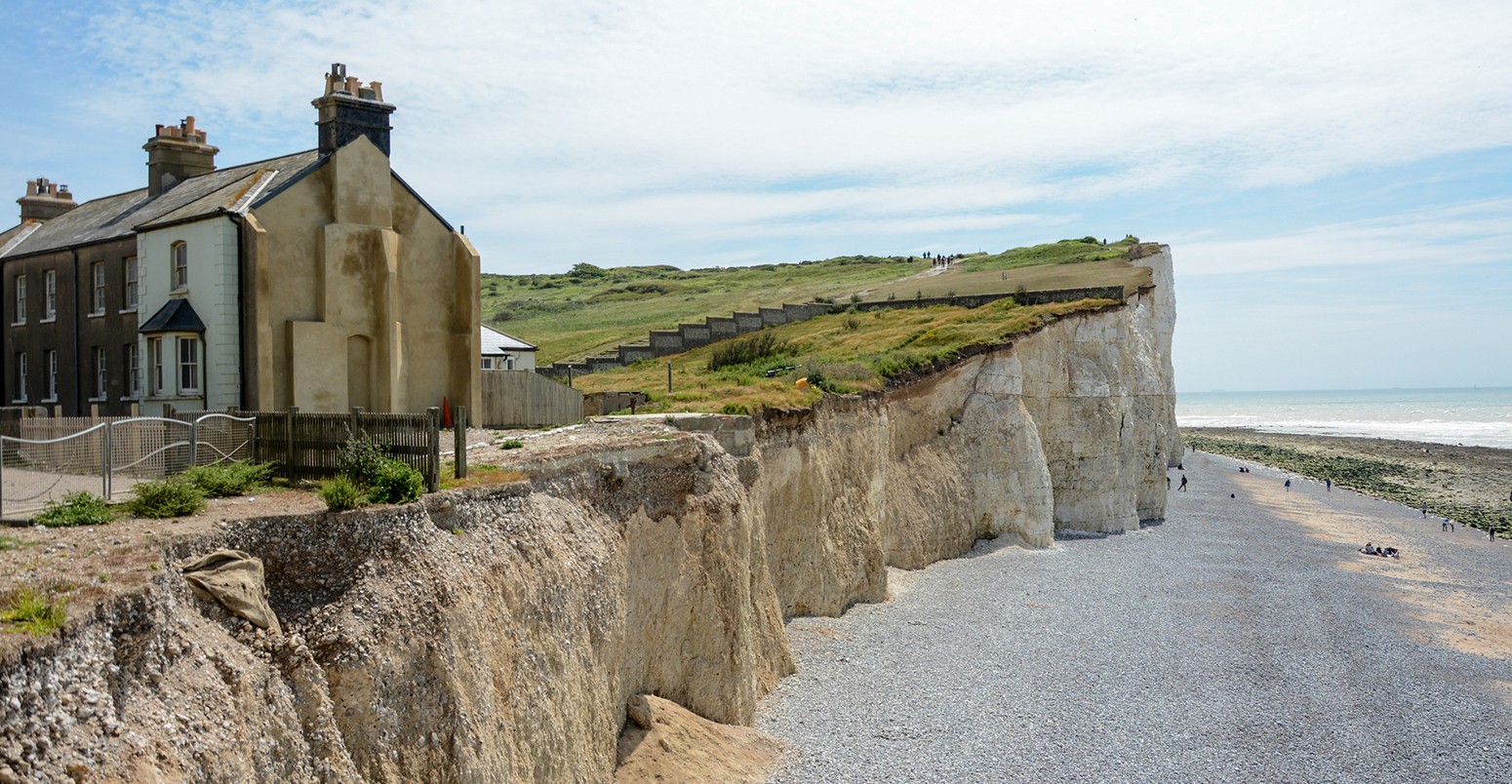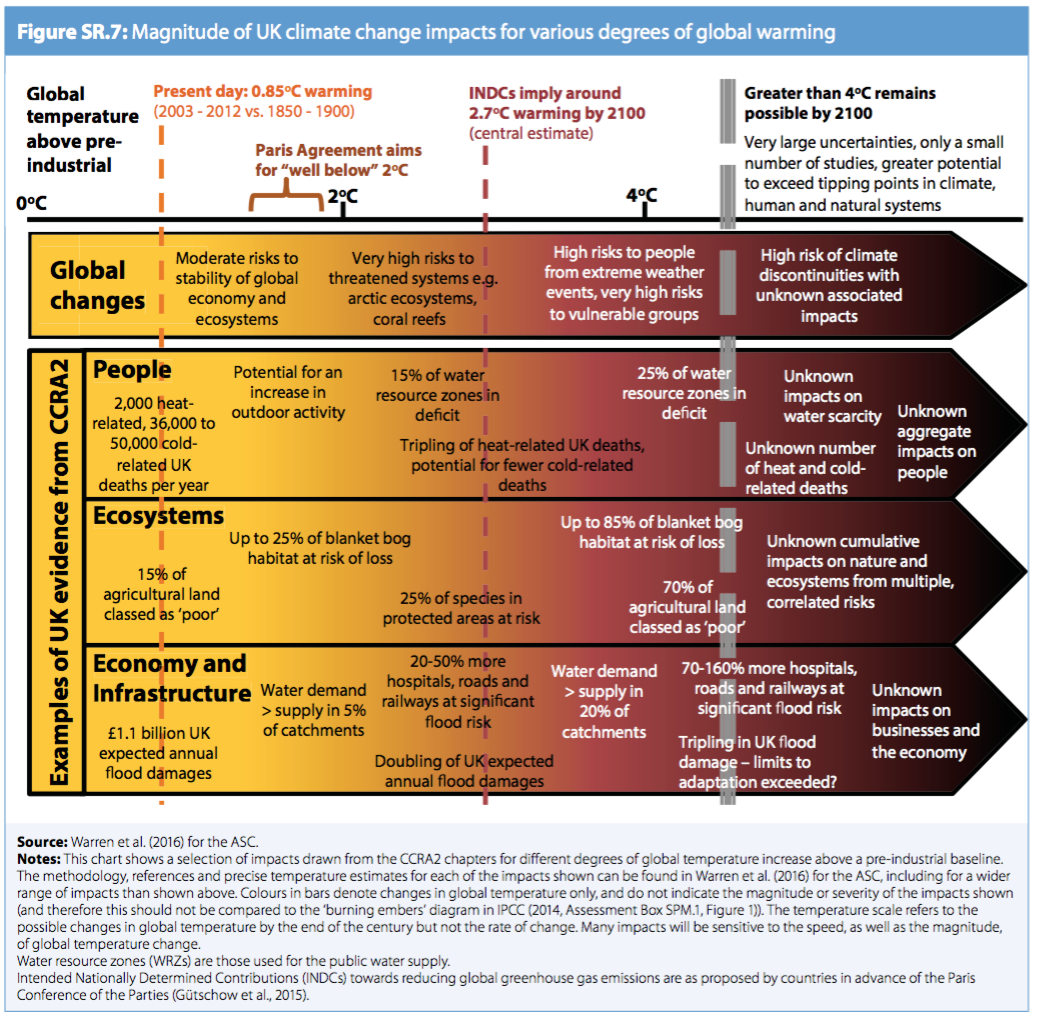
UK faces urgent climate change risks, says CCC
Sophie Yeo
07.12.16The UK must address a number of urgent risks due to climate change, the government’s climate advisers have warned.
Flooding, heat waves, water shortages, damage to nature, food insecurity and pests are major risks for the UK that demand immediate action, according to a report released today by the Committee on Climate Change (CCC).
These risks could lead to a plethora of problems for the UK by the middle of the century, including damage to vital infrastructure, an increase in mortality rates, higher food prices and disease. In some cases, the risks are already relevant today, says the report by the government’s advisory body.
Projections
The report was prepared by the CCC’s Adaptation Sub-Committee, as a requirement of the 2008 Climate Change Act.
This requires the government to assess the risks and opportunities of climate change relevant to the UK every five years and present a report to parliament. The first of these was published in 2012, and the UK’s National Adaptation Programme sprang off the back of it. The CCC prepares the evidence upon which these documents are based.
Today’s report contains the evidence that will inform the government’s second climate change risk assessment, which must be presented in 2017. The government is then expected to release its second National Adaptation Programme by the summer of 2018.
The report was released as an 80-page synthesis report. The entire document amounts to 2,000 pages of evidence collected by 80 authors over three years. It is based on both existing literature on the climate risks facing the UK, and a set of projections for the UK’s climate developed by the Met Office in 2009.
It also takes into account existing adaptation actions and international threats, alongside projected demographic and economic changes, to paint a full picture of the risks posed by climate change in the UK in decades to come.

Climate risks facing the UK across various temperature rise scenarios. Source: UK Climate Change Risk Assessment 2017 Synthesis Report, Committee on Climate Change
Urgency
The report assesses almost 60 individual risks and opportunities facing the UK as a result of climate change. These are grouped into six broad areas of risk, illustrated by the graphic below.

The top six risks facing the UK due to climate change. Source: UK Climate Change Risk Assessment 2017 Synthesis Report, Committee on Climate Change
Lord Krebs, who leads the CCC’s Adaptation Sub-Committee, says:
These six areas have each been assessed according to their level of urgency. In fact, the CCC has designated five out of the six categories with the highest possible urgency rating, “more action needed”. The sixth is labelled a “research priority”, which is the second most urgent category.
Flooding — more action needed
The first risk that the CCC has assessed is the impact of flooding and coastal change on communities, business and infrastructure. It has high confidence that this will pose a high magnitude risk both now and in the 2050s. This holds true across a range of climate change scenarios.
Damages from flooding and coastal change are already high, averaging around £1bn per year in the UK, and current adaptation measures are insufficient to protect the country from the impacts of further warming, says the report. With 4C of warming and high population growth, the number of households that have a significant chance of flooding could double by the 2050s, it adds. The report warns:
High temperatures — more action needed
The report says that, by the 2050s under a medium emissions scenario, high temperatures will be a high magnitude risk in the UK, taking a toll on mortality rates and wellbeing.
Average and extreme temperatures across the UK are expected to increase in the coming decades, and events such as the deadly 2003 heatwave could become the norm in the UK by the 2040s.
This will take place as the proportion of over-75s — the most vulnerable group to extreme temperatures — is increasing in the UK, with their share projected to grow from 8% in 2015 to 18% by 2085.
Water shortages — more action needed
Again, the CCC predicts that water scarcity will be a high magnitude risk for the UK by the 2050s, under scenarios of high emissions and population growth. In this case, demand for water could be more than 150% of available resources across many catchments in the UK.
This could require restrictions such as hosepipe bans and groundwater extraction by water companies, farmers and industry. The report points out that some scenarios for energy generation will require more water for cooling, especially if carbon capture and storage is fitted.
Natural capital — more action needed
Natural ecosystems will come under pressure in the future, according to the CCC, amounting to a high magnitude risk by the 2050s across a range of emissions scenarios.
Many species and ecosystems are already shifting their range in response to warmer land and seas, but their capacity to do so will be increasingly constrained by pressures including habitat loss, pollution, and the spread of invasive species.
Some of the main threats to the natural environment from climate change are the deterioration of high-grade agricultural land, degradation of peat upland habitats, loss of coastal habitats, and the loss of marine fisheries and wildlife.
Food security — more action needed
Domestic and international food production and trade is another high magnitude risk, assuming that temperature rise reaches 2C by the 2080s.
Only part of the story here originates in the UK. According to the report, about 60% of UK food comes from domestic production — the rest is imported.
While climate change could present new opportunities to increase domestic production, this will likely be limited by other effects, such as damage to the quality of soils and scarce water resources.
Risks from abroad include the increasing chance of extreme weather events, which could affect both production and supply chains. Incremental changes in the climate could also impact how food is produced, potentially raising the price of groceries in the UK.
Pests and diseases — research priority
The UK could be beset by an increase in pests and diseases as the climate changes, causing a potentially high magnitude risk for the future. However, the report says that confidence in this is currently low, and therefore more research is needed.
Nonetheless, it says that “it is likely that the range, activity and vector potential of some tick and mosquito species will increase across the UK with the risk of high magnitude impacts.” It highlights Lyme disease as a case in point, which is already increasing in occurrence across the UK.
Opportunities
The CCC is also bound to highlight any opportunities that could rise from climate change, of which there is a smattering — although the picture is often complicated.
For instance, the report says that a warmer climate could extend the growing season of certain high value crops, including grapes, olives and tomatoes. However, this will only take place if other threats are fended off, including damage to soils and water shortages.
Milder winters could also help to ease fuel poverty in the UK, as it would reduce the need to heat homes in the winter. But the report adds that, as the population ages, cold is expected to remain as the largest climate-related cause of death in the UK by some margin, and there is a danger that less frequent cold weather could lead to complacency.
There could also be some benefits for biodiversity, with parts of the UK and its oceans already being colonised by creatures that like warmer temperatures. But this could come at the expense of native flora and fauna that are suited to the current climate.
Tourism could provide another gain, with warmer temperatures encouraging more visits to the UK’s national parks, beaches and open spaces — though whether this becomes the pattern is more likely to be dominated by separate trends such as incomes levels and exchange rates.
Professor Piers Forster from the University of Leeds, who was not involved with the report, says:

